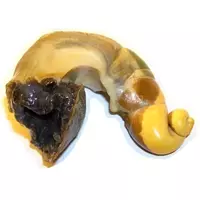Rapana clam

Rapana is one of the representatives of the genus of predatory gastropods. If about thirty years ago it was mined solely because of the beautiful shell that almost every vacationer acquired and took with him as a souvenir, now the main value of rapana mollusk is associated with its meat, which is considered a delicacy. Not all shellfish are used for food, but only its white meat (leg) and stomach. The rapana shell, once very valuable, is practically worthless at the moment.
There are not so many ways to prepare rapana clam: for example, you can make a very tasty soup from it. The meat of this predator is quite peculiar in taste - to some it resembles sturgeon, and to some it is comparable to squid. Just an excellent combination, some foodies call the shellfish rapana with mushrooms, and pickled in lemon or pomegranate juice, this seafood is an exquisite gastronomic delicacy. By the way, it is believed that rapana is the closest relative of the very disappeared mollusk, from the shells of which the ancient Phoenicians extracted their famous purple dye.
Interest in rapana shellfish is primarily due to the high nutritional value of its meat, which exceeds pet meat in protein content by 2 times. Due to its unique property, rapana mollusk, when eaten, causes greater release of gastric juice, which is why meat is digested and absorbed by the body much faster and better.
The benefits of rapana mollusk meat are also due to the ability to increase the overall tone of the body and contribute to tissue recovery after complex operations. Regular consumption of this seafood has a beneficial effect on the state of hematopoiesis, fat and vitamin metabolism. The body's resistance to cardiovascular diseases, infections and colds increases.
Rapan mollusk 76.7 kKal
Energy value of rapana mollusk (Ratio of proteins, fats, carbohydrates - ju):
Proteins: 16.7 (~ 67 kCal)
Fats: 1.1 g (~ 10 kCal)
Carbohydrates: 0 g (~ 0 kCal)
Energy ratio (b | y): 87% | 13% | 0%
 Español
Español Français
Français Português
Português Русский
Русский 简体中文
简体中文 繁體中文
繁體中文 日本語
日本語 한국어
한국어 العربية
العربية Türkçe
Türkçe Қазақ
Қазақ Deutsch
Deutsch Italiano
Italiano Українська
Українська
